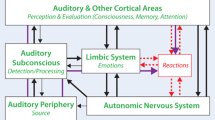Abstract
Two cases are reported in which subjective tinnitus aurium was treated with a matching-to-sample procedure. Following baseline evaluations, the subjects' experienced tinnitus was reproduced audiometrically in terms of loudness, frequency, and quality. This was presented to them in the noninvolved ear and was gradually reduced within sessions. The subjects were required to concentrate on reducing their tinnitus until an equal match had been achieved between it and the stimulus sound at each new decibel level. Both subjects gained control over their tinnitus and were able to reduce it markedly from baseline levels. This procedure is viewed as an advance over other techniques not only in that it significantly reduces the tinnitus but in the fact that it is done through the subject's own control, providing psychological benefit as well.
Similar content being viewed by others
References
Agnew, J. (1979). A guide to understanding tinnitus.Hear. Aid. J. July 6: 45–47.
Bailey, Q. (1979). Audiological aspects of tinnitus.Austral. J. Audiol. 1: 15–18.
Ballenger, J. J. (ed.) (1977).Diseases of the Nose, Throat and Ear, 12th ed., Lea and Feibiger, Philadelphia.
Borton, T. E., Moore, W. H., Jr., and Clark, S. R. (1981). Electromyographic feedback treatment for tinnitus aurium.J. Speech. Hear. Dis. 46: 39–45.
Donaldson, I. (1978). Tinnitus: A theoretical view and a therapeutic study using amylobabitone.J. Laryngol. Otol. 92: 123–130.
Goodwin, P. E. (1980). Tinnitus and auditory imagery.Am. J. Otol. 2: 5–9.
Graham, J. J., and Newby, H. A. (1962). Acoustical characteristics of tinnitus.Arch. Otolaryngol. 75: 82–87.
Grossan, M. (1976). Treatment of subjective tinnitus with biofeedback.ENT J. 55: 22–30.
House, J. W., Miller, L., and House, P. R. (1979). Treatment of tinnitus with biofeedback.Hear. Instrum. 9: 12–13.
Kiang, N. Y. S., Moxon, E. C., and Levine, R. A. (1970). Auditory-nerve activity in cats with normal and abnormal cochleas. In Wolstenholme, G. E. W., and Knight, J. (eds.),Sensorineural Hearing Loss, J & A Churchill, London.
Mawson, S. R. (1974).Diseases of the Ear, 3rd ed., Williams and Wilkins, Baltimore.
Meyerhoff, W. L., and Cooper, J. C. (1980). Tinnitus. In Paparella, M. M., and Shumrick, D. A. (eds.),Otolaryngology, Vol. II. The Ear, 2nd ed., Saunders, Philadelphia.
Mortimer, H., Burr, E. G., Wright, R. P., and McGarry, E. A. (1940). A clinical method for the localization of tinnitus and the measurement of its loudness level.Trans. Am. Laryngol. Rhinol. Otol. Soc. 46: 15–31.
Penner, M. J. (1983). The annoyance of tinnitus and the noise required to mask it.J. Speech. Hear. Res. 26: 73–76.
Pulec, J. L., Hodell, S. F., and Anthony, P. F. (1978). Tinnitus: Diagnosis and treatment.Ann. Otol. 87: 821–833.
Reed, G. F. (1960). An audiometric study of two hundred cases of subjective tinnitus.Arch. Otolaryngol. 71: 84–94.
Reidner, E. D., and Young, R. J. (1982). Experience with tinnitus therapy.Hear. Instrum. 33: 28–29.
Roeser, R. J., and Price, D. R. (1980). Clinical experience with tinnitus maskers.Ear Hear. 1: 63–68.
Shailer, M. J., Taylor, R. S., and Coles, R. R. A. (1981). Critical masking bands for tinnitus.Scand. Audiol. 10: 157–162.
Svihovec, D., and Carmen, R. (1982). Relaxation-biofeedback treatment for tinnitus.Hear. Instrum. 33: 59–61.
Travis, L. E. (ed.) (1971).Handbook of Speech Pathology and Audiology, Appleton-Century-Crofts, New York.
Tyler, R. S., and Conrad-Armes, D. (1983). The determination of tinnitus loudness considering the effects of recruitment.J. Speech Hear. Res. 26: 59–72.
Yanick, P., Jr. (1982). New Hope for hearing and tinnitus problems: Nutrition and biochemistry.Hear. Instrum. 33: 34–36.
Author information
Authors and Affiliations
Additional information
This study was conducted under the joint auspices of the Psychology Service and the Speech Pathology and Audiology Service, Department of Rehabilitation Medicine, Goldwater Memorial Hospital.
Rights and permissions
About this article
Cite this article
Ince, L.P., Greene, R.Y., Alba, A. et al. Learned self-control of tinnitus through a matching-to-sample feedback technique: A clinical investigation. J Behav Med 7, 355–365 (1984). https://doi.org/10.1007/BF00845269
Accepted:
Issue Date:
DOI: https://doi.org/10.1007/BF00845269




